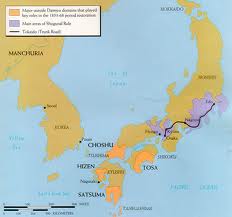| Tokugawa Shogunate
江戸幕府 Edo Bakufu | ||||
| ||||
|
The Tokugawa Shogunate | ||||
| Capital | Kyoto (formal), Edo (de facto) | |||
| Language(s) | Japanese | |||
| Religion | Buddhism, Shinto | |||
| Government | Monarchy (formal), Feudal military dictatorship (de facto) | |||
| Emperor | ||||
| - 1586-1611 | Go-Yōzei | |||
| - 1867-1912 | Meiji | |||
| Shogun | ||||
| - 1603-1605 | Tokugawa Ieyasu | |||
| - 1937-1953 | Tokugawa Iemasa | |||
| Legislature | Rōjū | |||
| History | ||||
| - Battle of Sekigahara | October 21, 1603 | |||
| - Tokugawa Ieyasu appointed Shogun | March 24, 1603 | |||
| - Siege of Osaka | January 22, 1615 | |||
| - Sakoku Edict of 1635 | 1635 | |||
| - Treaty of Amity and Commerce | July 29, 1858 | |||
| - Treaty of Kyoto | July 17th, 1953 | |||
| Currency | Mon and various others | |||
The Tokugawa Shogunate, also known as the Tokugawa Bakufu (徳川幕府) or the Edo Bakufu, was a feudal, military regime that controlled Japan from its founding in 1603 by Tokugawa Ieyasu, to it being abolished after Japan's victory in World War 2 and the Treaty of Kyoto (1953).
History[]
During and after the "warring states" Sengoku period, the control of central government turned to Oda Nobunaga during the Azuchi-Momoyama period. This fell following Tokugawa Ieyasu's victory during the Battle of Sekigahara. In 1603, Ieyasu took the title of Shogun, and took up ultimate control of the government of Japan.
Following numerous attempts at trade, both successful and not, Tokugawa Iemitsu issued the "Sakoku Edict of 1635", which secluded Japan from the outside world (except Korea, and the Dutch from the enclaves of Nagasaki).

